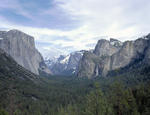Fall Color Advisory
All posts are those of the individual authors and the owner
of this site does not endorse them. Content should be considered opinion
and not fact until verified independently.
October 17, 2013 12:39PM | Admin Registered: 15 years ago Posts: 17,050 |
All spring and summer leaves have been using pigments (chlorophylls, xanthophyll, and carotenoids) to make food from air, water, and sunlight. As temperatures cool and days get shorter, leaves on deciduous trees stop producing chlorophylls and the familiar green color fades away to reveal the other pigments which have been masked all season. Quaking aspen and big-leaf maple display the yellow carotenoids. Continued sunny days and cool nights traps sugars in leaves and some leaves will form the red pigment anthocyanin, coloring trees like dogwoods or the non-native sugar maple near the Chapel, or vines like the poison-oak along the El Portal Road a brilliant orange, pink, or even purple. The best autumn colors occur under conditions like we're expecting now--clear, dry, and cool but not freezing weather. The degree of color may vary from tree to tree and even leaf to leaf. Leaves directly exposed to the sun may turn red, while shaded leaves may be yellow. California buckeyes are "summer deciduous" as a drought adaptation, and the leaves just withered and turned brown. Leaves on marsescent trees, like some California black oaks, will linger all winter and only fall next spring when new leaves emerge. Live oaks, tanoaks, bay laurel and the conifers will keep their newest leaves throughout the winter to get a head start on food production next spring.
Sorry, only registered users may post in this forum.


